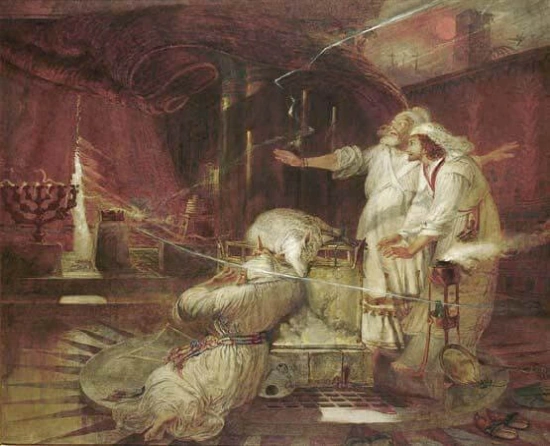1
και-C λαλεω-VAI-AAI3S κυριος-N2--NSM προς-P *μωυσης-N1M-ASM λεγω-V1--PAPNSM
2
εν-P ημερα-N1A-DSF εις-A1A-DSF ο-
A--GSM μην-N3--GSM ο-
A--GSM πρωτος-A1--GSMS νουμηνια-N1A-DSF ιστημι-VF--FAI2S ο-
A--ASF σκηνη-N1--ASF ο-
A--GSN μαρτυριον-N2N-GSN
3
και-C τιθημι-VF--FAI2S ο-
A--ASF κιβωτος-N2--ASF ο-
A--GSN μαρτυριον-N2N-GSN και-C σκεπαζω-VF--FAI2S ο-
A--ASF κιβωτος-N2--ASF ο-
A--DSN καταπετασμα-N3M-DSN
4
και-C ειςφερω-VF--FAI2S ο-
A--ASF τραπεζα-N1S-ASF και-C προτιθημι-VF--FAI2S ο-
A--ASF προθεσις-N3I-ASF αυτος-
D--GSF και-C ειςφερω-VF--FAI2S ο-
A--ASF λυχνια-N1A-ASF και-C επιτιθημι-VF--FAI2S ο-
A--APM λυχνος-N2--APM αυτος-
D--GSF
5
και-C τιθημι-VF--FAI2S ο-
A--ASN θυσιαστηριον-N2N-ASN ο-
A--ASN χρυσους-A1C-ASN εις-P ο-
A--ASN θυμιαω-V3--PAN εναντιον-P ο-
A--GSF κιβωτος-N2--GSF και-C επιτιθημι-VF--FAI2S καλυμμα-N3M-ASN καταπετασμα-N3M-GSN επι-P ο-
A--ASF θυρα-N1A-ASF ο-
A--GSF σκηνη-N1--GSF ο-
A--GSN μαρτυριον-N2N-GSN
6
και-C ο-
A--ASN θυσιαστηριον-N2N-ASN ο-
A--GPN καρπωμα-N3M-GPN τιθημι-VF--FAI2S παρα-P ο-
A--APF θυρα-N1A-APF ο-
A--GSF σκηνη-N1--GSF ο-
A--GSN μαρτυριον-N2N-GSN
8
και-C περιτιθημι-VF--FAI2S ο-
A--ASF σκηνη-N1--ASF και-C πας-A3--APN ο-
A--APN αυτος-
D--GSF αγιαζω-VF--FAI2S κυκλος-N2--DSM
9
και-C λαμβανω-VF--FMI2S ο-
A--ASN ελαιον-N2N-ASN ο-
A--GSN χρισμα-N3M-GSN και-C χριω-VF--FAI2S ο-
A--ASF σκηνη-N1--ASF και-C πας-A3--APN ο-
A--APN εν-P αυτος-
D--DSF και-C αγιαζω-VF--FAI2S αυτος-
D--ASF και-C πας-A3--APN ο-
A--APN σκευος-N3E-APN αυτος-
D--GSF και-C ειμι-VF--FMI3S αγιος-A1A-APN
10
και-C χριω-VF--FAI2S ο-
A--ASN θυσιαστηριον-N2N-ASN ο-
A--GPN καρπωμα-N3M-GPN και-C πας-A3--APN αυτος-
D--GSN ο-
A--APN σκευος-N3E-APN και-C αγιαζω-VF--FAI2S ο-
A--ASN θυσιαστηριον-N2N-ASN και-C ειμι-VF--FMI3S ο-
A--ASN θυσιαστηριον-N2N-ASN αγιος-A1A-ASN ο-
A--GPN αγιος-A1A-GPN
12
και-C προςαγω-VF--FAI2S *ααρων-N---ASM και-C ο-
A--APM υιος-N2--APM αυτος-
D--GSM επι-P ο-
A--APF θυρα-N1A-APF ο-
A--GSF σκηνη-N1--GSF ο-
A--GSN μαρτυριον-N2N-GSN και-C λουω-VF--FAI2S αυτος-
D--APM υδωρ-N3T-DSN
13
και-C ενδυω-VF--FAI2S *ααρων-N---ASM ο-
A--APF στολη-N1--APF ο-
A--APF αγιος-A1A-APF και-C χριω-VF--FAI2S αυτος-
D--ASM και-C αγιαζω-VF--FAI2S αυτος-
D--ASM και-C ιερατευω-VF--FAI3S εγω-
P--DS
14
και-C ο-
A--APM υιος-N2--APM αυτος-
D--GSM προςαγω-VF--FAI2S και-C ενδυω-VF--FAI2S αυτος-
D--APM χιτων-N3W-APM
15
και-C αλειφω-VF--FAI2S αυτος-
D--APM ος-
--ASM τροπος-N2--ASM αλειφω-VAI-AAI2S ο-
A--ASM πατηρ-N3--ASM αυτος-
D--GPM και-C ιερατευω-VF--FAI3P εγω-
P--DS και-C ειμι-VF--FMI3S ωστε-C ειμι-V9--PAN αυτος-
D--DPM χρισμα-N3M-NSN ιερατεια-N1A-GSF εις-P ο-
A--ASM αιων-N3W-ASM εις-P ο-
A--APF γενεα-N1A-APF αυτος-
D--GPM
16
και-C ποιεω-VAI-AAI3S *μωυσης-N1M-NSM πας-A3--APN οσος-A1--APN εντελλομαι-VAI-AMI3S αυτος-
D--DSM κυριος-N2--NSM ουτως-D ποιεω-VAI-AAI3S
17
και-C γιγνομαι-VBI-AMI3S εν-P ο-
A--DSM μην-N3--DSM ο-
A--DSM πρωτος-A1--DSMS ο-
A--DSN δευτερος-A1A-DSN ετος-N3E-DSN εκπορευομαι-V1--PMPGPM αυτος-
D--GPM εκ-P *αιγυπτος-N2--GSF νουμηνια-N1A-DSF ιστημι-VCI-API3S ο-
A--NSF σκηνη-N1--NSF
18
και-C ιστημι-VAI-AAI3S *μωυσης-N1M-NSM ο-
A--ASF σκηνη-N1--ASF και-C επιτιθημι-VAI-AAI3S ο-
A--APF κεφαλις-N3D-APF και-C δια ενβαλλω-VBI-AAI3S ο-
A--APM μοχλος-N2--APM και-C ιστημι-VAI-AAI3S ο-
A--APM στυλος-N2--APM
19
και-C εκτεινω-VAI-AAI3S ο-
A--APF αυλαια-N1A-APF επι-P ο-
A--ASF σκηνη-N1--ASF και-C επιτιθημι-VAI-AAI3S ο-
A--ASN κατακαλυμμα-N3M-ASN ο-
A--GSF σκηνη-N1--GSF επι-P αυτος-
D--GSF ανωθεν-D καθα-D συντασσω-VAI-AAI3S κυριος-N2--NSM ο-
A--DSM *μωυσης-N1M-DSM
20
και-C λαμβανω-VB--AAPNSM ο-
A--APN μαρτυριον-N2N-APN ενβαλλω-VBI-AAI3S εις-P ο-
A--ASF κιβωτος-N2--ASF και-C υποτιθημι-VAI-AAI3S ο-
A--APM διωστηρ-N3--APM υπο-P ο-
A--ASF κιβωτος-N2--ASF
21
και-C ειςφερω-VAI-AAI3S ο-
A--ASF κιβωτος-N2--ASF εις-P ο-
A--ASF σκηνη-N1--ASF και-C επιτιθημι-VAI-AAI3S ο-
A--ASN κατακαλυμμα-N3M-ASN ο-
A--GSN καταπετασμα-N3M-GSN και-C σκεπαζω-VAI-AAI3S ο-
A--ASF κιβωτος-N2--ASF ο-
A--GSN μαρτυριον-N2N-GSN ος-
--ASM τροπος-N2--ASM συντασσω-VAI-AAI3S κυριος-N2--NSM ο-
A--DSM *μωυσης-N1M-DSM
22
και-C τιθημι-VAI-AAI3S ο-
A--ASF τραπεζα-N1S-ASF εις-P ο-
A--ASF σκηνη-N1--ASF ο-
A--GSN μαρτυριον-N2N-GSN επι-P ο-
A--ASN κλιτος-N3E-ASN ο-
A--GSF σκηνη-N1--GSF ο-
A--GSN μαρτυριον-N2N-GSN ο-
A--ASN προς-P βορεας-N1T-ASM εξωθεν-D ο-
A--GSN καταπετασμα-N3M-GSN ο-
A--GSF σκηνη-N1--GSF
23
και-C προτιθημι-VAI-AAI3S επι-P αυτος-
D--GSF αρτος-N2--APM ο-
A--GSF προθεσις-N3I-GSF εναντι-P κυριος-N2--GSM ος-
--ASM τροπος-N2--ASM συντασσω-VAI-AAI3S κυριος-N2--NSM ο-
A--DSM *μωυσης-N1M-DSM
24
και-C τιθημι-VAI-AAI3S ο-
A--ASF λυχνια-N1A-ASF εις-P ο-
A--ASF σκηνη-N1--ASF ο-
A--GSN μαρτυριον-N2N-GSN εις-P ο-
A--ASN κλιτος-N3E-ASN ο-
A--GSF σκηνη-N1--GSF ο-
A--ASN προς-P νοτος-N2--ASM
25
και-C επιτιθημι-VAI-AAI3S ο-
A--APM λυχνος-N2--APM αυτος-
D--GSF εναντι-P κυριος-N2--GSM ος-
--ASM τροπος-N2--ASM συντασσω-VAI-AAI3S κυριος-N2--NSM ο-
A--DSM *μωυσης-N1M-DSM
26
και-C τιθημι-VAI-AAI3S ο-
A--ASN θυσιαστηριον-N2N-ASN ο-
A--ASN χρυσους-A1C-ASN εν-P ο-
A--DSF σκηνη-N1--DSF ο-
A--GSN μαρτυριον-N2N-GSN απεναντι-P ο-
A--GSN καταπετασμα-N3M-GSN
27
και-C θυμιαω-VAI-AAI3S επι-P αυτος-
D--GSN ο-
A--ASN θυμιαμα-N3M-ASN ο-
A--GSF συνθεσις-N3I-GSF καθαπερ-D συντασσω-VAI-AAI3S κυριος-N2--NSM ο-
A--DSM *μωυσης-N1M-DSM
29
και-C ο-
A--ASN θυσιαστηριον-N2N-ASN ο-
A--GPN καρπωμα-N3M-GPN τιθημι-VAI-AAI3S παρα-P ο-
A--APF θυρα-N1A-APF ο-
A--GSF σκηνη-N1--GSF
33
και-C ιστημι-VAI-AAI3S ο-
A--ASF αυλη-N1--ASF κυκλος-N2--DSM ο-
A--GSF σκηνη-N1--GSF και-C ο-
A--GSN θυσιαστηριον-N2N-GSN και-C συντελεω-VAI-AAI3S *μωυσης-N1M-NSM πας-A3--APN ο-
A--APN εργον-N2N-APN
34
και-C καλυπτω-VAI-AAI3S ο-
A--NSF νεφελη-N1--NSF ο-
A--ASF σκηνη-N1--ASF ο-
A--GSN μαρτυριον-N2N-GSN και-C δοξα-N1S-GSF κυριος-N2--GSM πιμπλημι-VSI-API3S ο-
A--NSF σκηνη-N1--NSF
35
και-C ου-D δυναμαι-VSI-API3S *μωυσης-N1M-NSM ειςερχομαι-VB--AAN εις-P ο-
A--ASF σκηνη-N1--ASF ο-
A--GSN μαρτυριον-N2N-GSN οτι-C επισκιαζω-V1I-IAI3S επι-P αυτος-
D--ASF ο-
A--NSF νεφελη-N1--NSF και-C δοξα-N1S-GSF κυριος-N2--GSM πιμπλημι-VSI-API3S ο-
A--NSF σκηνη-N1--NSF
36
ηνικα-D δε-X αν-X αναβαινω-VZI-AAI3S ο-
A--NSF νεφελη-N1--NSF απο-P ο-
A--GSF σκηνη-N1--GSF αναζευγνυω-VAI-AAI3P ο-
A--NPM υιος-N2--NPM *ισραηλ-N---GSM συν-P ο-
A--DSF απαρτια-N1A-DSF αυτος-
D--GPM
37
ει-C δε-X μη-D αναβαινω-VZI-AAI3S ο-
A--NSF νεφελη-N1--NSF ου-D αναζευγνυω-VAI-AAI3P εως-P ο-
A--GSF ημερα-N1A-GSF ος-
--GSF αναβαινω-VZI-AAI3S ο-
A--NSF νεφελη-N1--NSF
38
νεφελη-N1--NSF γαρ-X ειμι-V9--IAI3S επι-P ο-
A--GSF σκηνη-N1--GSF ημερα-N1A-GSF και-C πυρ-N3--NSN ειμι-V9--IAI3S επι-P αυτος-
D--GSF νυξ-N3--GSF εναντιον-P πας-A3--GSM *ισραηλ-N---GSM εν-P πας-A1S-DPF ο-
A--DPF αναζυγη-N1--DPF αυτος-
D--GPM








